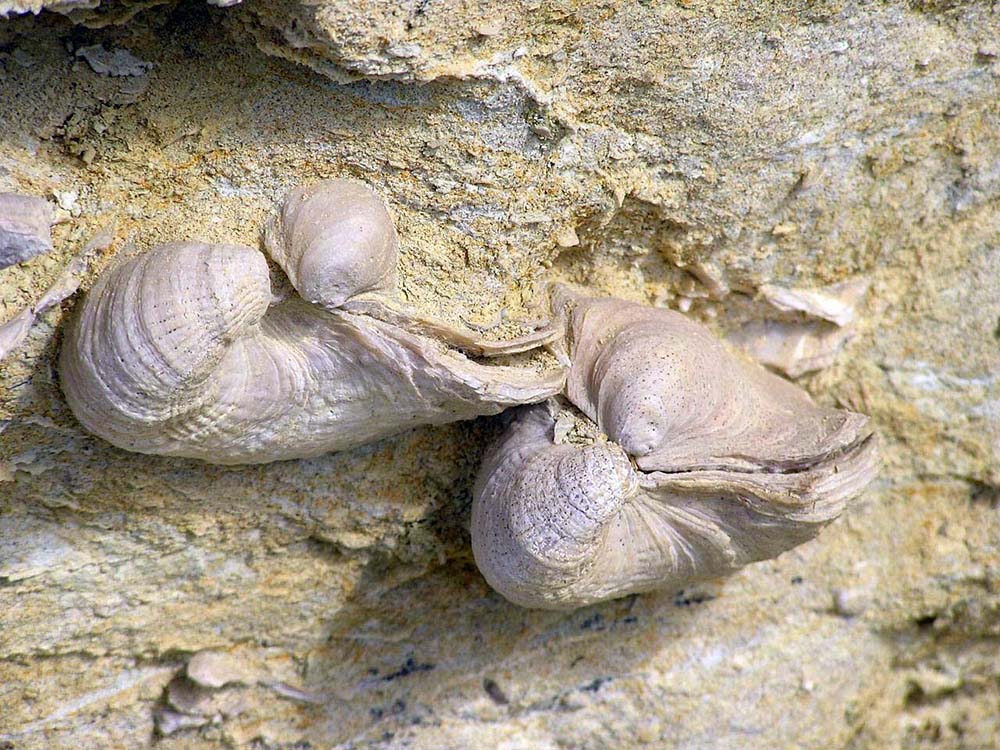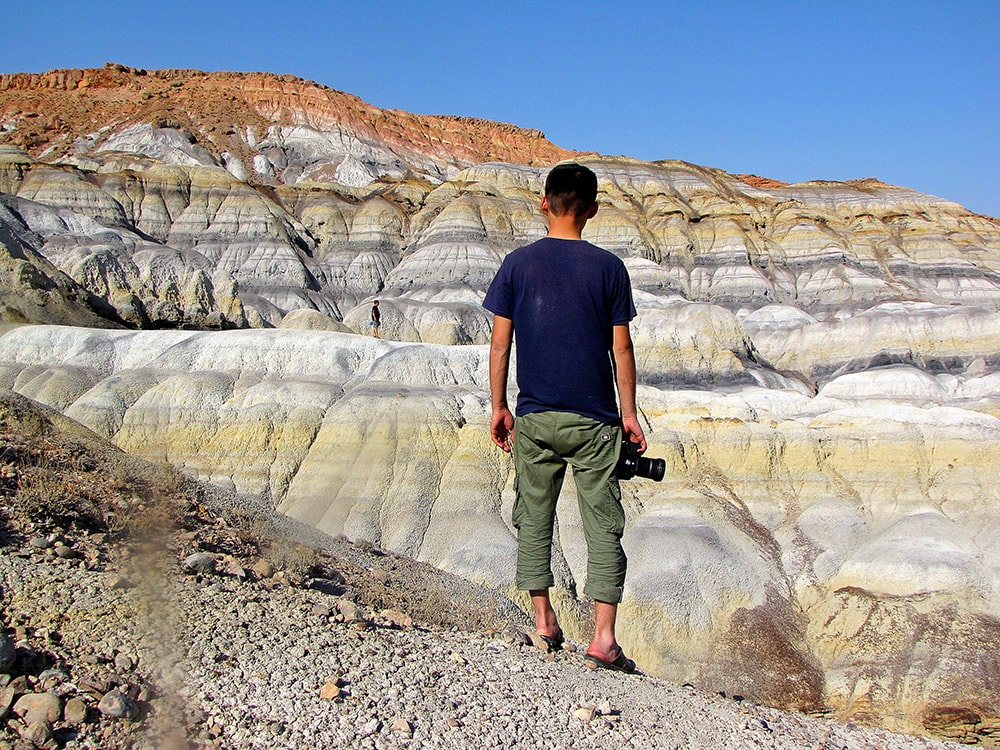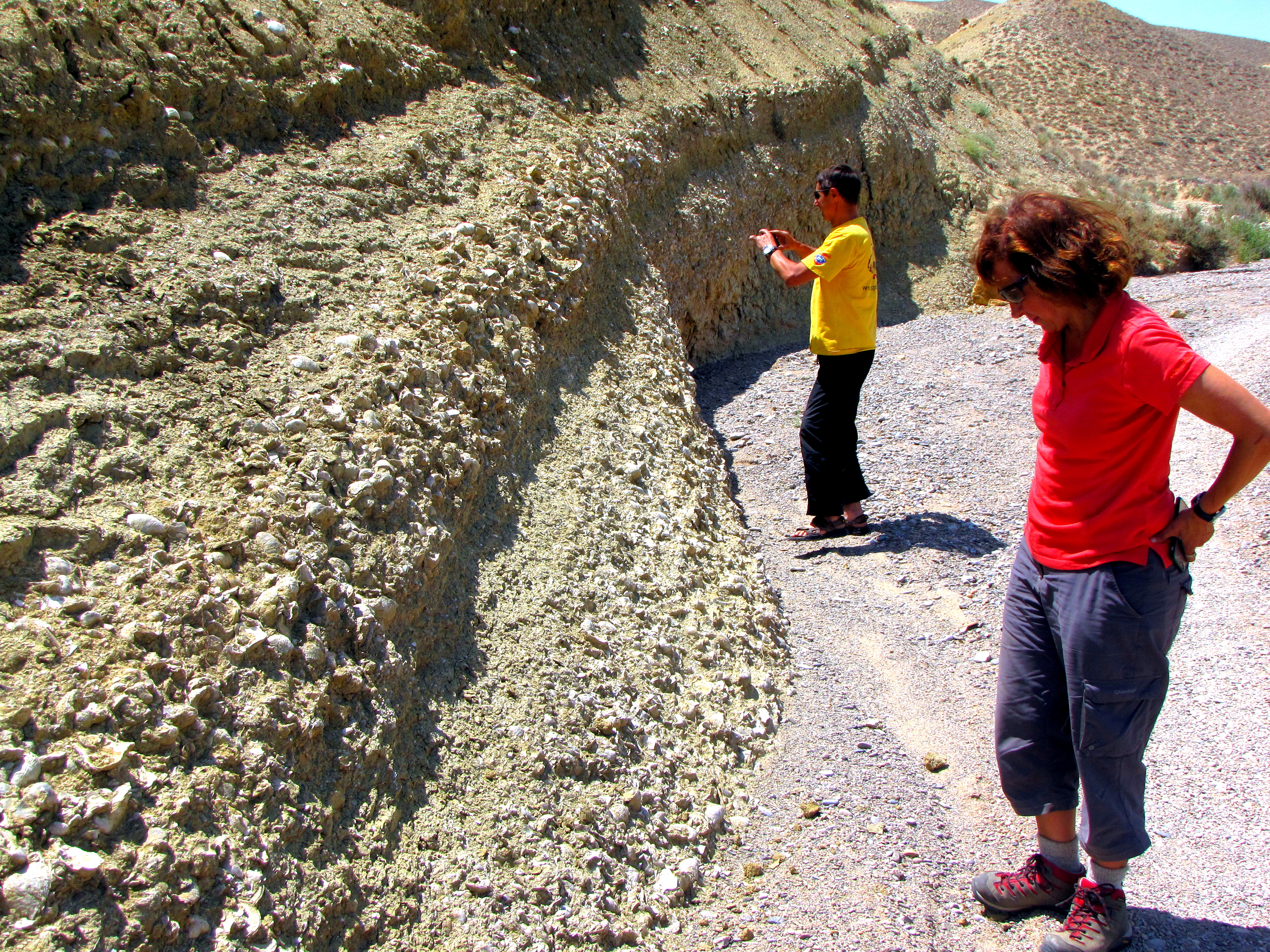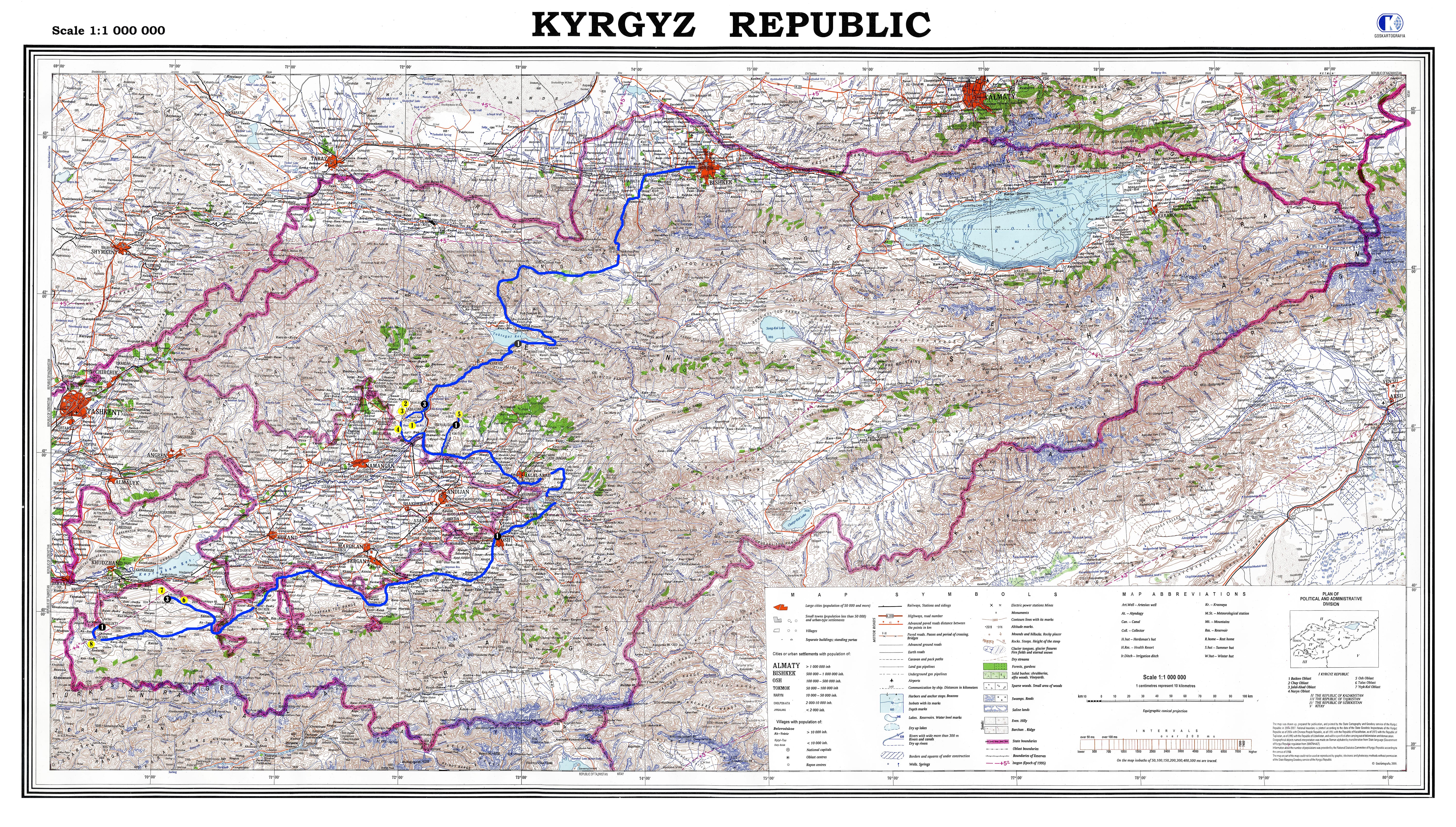Dates can be changed for individual groups.
An alternative tour option for 8 days is presented below
… This part of the land was covered by an ocean in ancient geological times. This is indicated by fossils found in rocks, indicating a diverse marine life millions of years old. But besides the fossils, in this semi-desert area, people find traces of ancient nomads and cultures that lived in this arid area….
The world-famous place “Madygen” with its Madygen formation is a representative place where rare fossils that allowed reconstructing the paleo-climate, paleogeography and geological history on the Eurasian continent were found. There are more than 20 locations of dinosaur remains in Kyrgyzstan. But there are two of the most extensive regions where you can long and enthusiastically explore the ancient life of the Mesozoic era. These territories are composed of Triassic, Jurassic and Cretaceous layers creating magnificent landscapes. During our research expedition we will visit these two famous areas.
The trip lasts 14 days. This trip can be reduced to 7 days by visiting only one of the areas of interest to you. The optimal number of participants is 2-20 people. The program is flexible. We can offer to explore other paleontological areas or individual locations of fossils. Another option to start this trip is flying to the Osh City. But we recommend starting from Bishkek, which will diversify the route and you will familiarize with the country. During the trip, both hotels and a field camp will be used for recreation.
Briefing presentation of the program. Overnight at hotel.
The road from Bishkek to the Toktogul reservoir is about 350 km. Leaving Bishkek, we will rid ourselves of the city heat and discuss all the details of the trip, on the shore of a clean and cool water reservoir. Here we will give you a lecture on the ancient paleo-geological and paleo-climatic conditions of the Tien-Shan; we will get acquainted with its geological history. Spending time on the shore of the reservoir is the best way to become better acquainted with the paleontologist guides, famous geologists and experts in Central Asia. We will stay in a cozy hotel on the shore of the reservoir. The Toktogul Reservoir is the largest water reservoir in Central Asia. Overnight at the hotel on the shore of the reservoir.
In Soviet times, the Tash-Kumyr City was the largest center of coal mining in Kyrgyzstan. Coal deposits formed in the Jurassic period. After the collapse of the USSR, coal mining in Tash-Kumyr stopped and the city began to die. Residents of the city with regret left in search of a better life. But we are interested in the local fossil fauna. To the west of the Tash-Kumyr City there is a small settlement Kyzyl-Jar (Red Land) with a similar fate of abandoned cities. Secret mining of rare ores were once conducted here. This village is surrounded by a landscape between semi-desert and savannah. This place is an object of study of paleontologists and our first stop to search for dinosaur remains, Location 1. The field camp site is located at the mouth of the Kara-Suu River; a tributary of the Naryn River, the only place with big amounts of drinking water. But we will choose a more comfortable option in a hotel. Overnight at hotel.
Excursion to Balabansai, 5 km north-north-west from the city of Tash-Kumyr. We will conduct field observations and research here, Location 2. In 1966-1967 various and numerous dinosaur remains were found here. They were located in the geological strata of the Middle Jurassic (callovian) age (J2). These were parts of the skeleton of a Sauropod, (pelvic bones, sacrum, part of the femur, several trunk, sacral and caudal vertebrae). A complete skeleton of a giant Sauropod was also found. Most of the skeleton was excavated, only the skull and part of the tail were not preserved. This specimen – the most complete dinosaur skeleton found in Kyrgyzstan, remains today one of the largest representatives of Sauropods in Central Asia. Such a find is of great interest and value. First of all, this is the first skeleton of a giant dinosaur, a Sauropod, which was 20 m long. The Tash-Kumyr dinosaur is more ancient than other available finds of Middle Jurassic dinosaurs in Central Asia. The study of the Fergana lizard, or "Ferganosaurus", allowed scientists to open a new page in the history of dinosaurs. This is find of a Sauropod, has become the most important among the locations of dinosaurs and mammals in Central Asia. Among the Central Asian faunas, these finds serve as a connecting link between Asian fossils and European fossils, and thus are among the links in the history of the organic world. It is impossible, of course, to forget about the significance of the obtained paleontological data for the geological study of the continental deposits of Central Asia.
During the tour, we can do a search for the remains of dinosaurs. The most convenient way to search is if you go to the cross of the strike of geological layers from the base of the slope to the very crest of the small mountain range of Char-Tash. From the limestone plateau we will be able to observe magnificent panoramas of the landscape, resembling something between a savannah and a semi-desert. In the afternoon we have the next excursion. 4 km north-west of the Tash-Kumyr City , where there are extensive dry gorges with Upper Cretaceous tiers (lower campanian, santonian, upper aptian). In red siltstones and sandstones are many-tier places of dinosaur eggs, Location 3. Here were found and described several levels with shell of dinosaur eggs of various types, among which there is a shell from a hadrosaurus, and also probably from a small theropods and shell from a ceratops. Here you can find places that talk about the dinosaur colonial nests. Overnight at guest house.
Excursion to the Char-Tash mountain range, Location 4. Here, in the layers of the Upper Cretaceous (K2), the lower campanian, eggshells and dinosaur bones were discovered. Separate bones of lizards were found along with the eggs. Perhaps we will be able to find here one of the most common inhabitants of the coastal lakeshores of Central Asia – the protoceratops. Approximately 70–90 million years ago, in the Late Cretaceous, the protoceratops dwelt — small, up to 1.5 m long, herbivorous reptiles from the group of horned dinosaurs. Currently are known, only the nests and eggs found in the Cretaceous sediments in the Gobi Desert, both in Mongolia and China. Together with the eggs, whole skeletons and individual bones of dinosaurs were found, old, young and very young.
A further tour of the dry gorges and plateaus will allow you to enjoy the magnificent landscape, combining the shroud and the badlands. The tour continues in the vicinity of the village of Kyzyl-Jar. It is located in a semi-desert area, once representing the oasis of life for miners of a bygone communist era. Here you can get acquainted with various forms of relief, forming ensembles of multi-colored rocks and stone sculptures. This area is the hottest place in Kyrgyzstan. At different times of the year, the crests of the motley mountains, valleys and highlands of Kyzyl-Jar change colors. In the autumn after a long sun, the area truly takes on a dry yellow desert look with rare burnt out shrubs, pistachio and almond trees. In May and April, the vicinity takes on the appearance of a savannah. Locals call these mountains Char-Tash. Overnight at guest house.
Today we will make a trip to the Mailuu-Suu town. During the USSR, the city was classified and closed to the public. It was possible to come here with a special pass. In the middle of the 20th century, ore was mined in the vicinity of the city. This city originated during the Second World War. Its main builders were prisoners of war, and the workers in underground mines were politically incarcerated. Streets and buildings combine the era of Stalin and the later times of the Soviet period. The city is located in the narrow valley of the Mailuu-Suu River and is surrounded by numerous landslides that occur on the slopes of the surrounding mountains. Landslides are formed in Cenozoic loams overlying the top of the Mesozoic limestone and sandy layers of rock. One of these landslides was formed on a sloping layer of limestone of Cretaceous age, which served as an excellent sliding surface for soil masses. As a result, prints of dinosaur tracks were exposed on the surface of the limestone layer. The prints are on the very edge of a 50-meter cliff. The size of these prints is 20 cm; the step width is 70 cm.
Who could have belonged to these traces in the Late Cretaceous? In order to answer this question, we will take a trip to a small plateau of dinosaurs, Location 5. The trail to the plateau runs along a steep slope, overgrown with shrubs, wild almond trees, pistachios and apple trees. The surface of the slope is subject to slow ground slide. Next, on the edge of the cliff, we will conduct a field lecture on Kyrgyz Cretaceous dinosaurs. We will tell you about the paleontological finds made in the vicinity of the city. The local guide will give a brief insight into the history of the town of Mailuu-Suu and the events that developed around the first atomic bomb of the USSR. Overnight at hotel.
A trip to the Osh City. The city of Osh is one of the largest ancient centers of the Great Silk Road. On the way, an excursion to the architectural and historical complex in the Uzgen City – the minaret and the mausoleum of the Karakhanids - IX c. Dinner at a national restaurant in Osh. Overnight at hotel.
Today we travel to the west of Kyrgyzstan, to the famous paleontological region of Madygen. Our field camp is located in a picturesque oasis, representing a poplar grove. The size of the old poplars is impressive. This is the only place where there is drinking water and a great opportunity to escape from the heat. In the evening, we will have a lecture on the topic “Madygen, a representative paleontological region of the Eurasian continent and the world”. Isolated fossil finds in the vicinity of Madygen have been made. Overnight in tents
Today we will see unique landscapes. We will observe and photograph the magnificent colored panoramas of the Mesozoic age. We will study paleontological cuts and mineral formations of peneplains, Location 6. Overnight at Madygen field camp.
Today we will study the thenatocenosis and geological formations, Location 7. The Madygen formation in southwest Kyrgyzstan gained worldwide fame for paleontologists for its exquisite number of preserved insects and late Triassic plants – the time when the earliest dinosaurs walked the earth – 250 million years ago.
What is the Madygen formation? The Madygen Formation is a rock formation of the Triassic age. It consists of terrestrial, lake and river sediments. Many fossil vertebrates have been found from the formation, including cartilaginous fish and unusual Triassic reptiles, such as the Sharovipteryx and the Longisquama. There is also a large variety of fossil insects from this area, with the Titanoptera being a prominent example. Endemics were discovered in single copies in Madygen, which became the only missing links in the reconstruction of the Eurasian Mesozoic paleogeography. Here were found: Palaeoxyris – Hybodontidae, Fayolia – egg capsule of prehistoric sharks, lonchidion ferganensis, as well as the Madygenerpeton pustulatus, Triassurus sixtelae, Reptiles – Kyrgyzsaurus bukhanchenkoi.. The oldest known drepanosaur, is the first Asian drepanosaur. One of the most interesting finds found in Madygen is the Longisquama insignis, it was a small reptile that lived during the Triassic about 235 million years ago. The world's only find of the Sharovipteryx mirabilis was found here. And also the Madysaurus sharovi. After a great excursion, we return to the field camp. Overnight at field camp.
Transfer to Andarak – a small settlement in the west of Kyrgyzstan, surrounded by semi-desert terrain, Location 8. This is the location of the remains of dinosaurs, located near the village of the same name, in the northern foothills of the Turkestan Range. A large number of teeth and individual bones of the skeleton of the Eocene tapirs and rhinos were found here. Along with them came turtles, teeth of crocodiles, sharks and stingrays. This location was formed in the coastal part of the sea, and continental and marine fauna mixed in the burial here. If a skull is needed for the exact species definition of reptiles, then teeth are enough to make a definition of mammals, since they are highly differentiated (unlike reptiles and lower vertebrates). Therefore, even individual teeth of mammals are already of a certain scientific value. Overnight at the hotel in the city of Sulukta.
In Haidarkan, an excursion to the Sel-Unkur cave – the cultural site of a Paleolithic man - 1.5 million years, Location 9. Overnight at the hotel in Kadamjay.
Return to Osh. On the way, excursion to the Abshyr-Ata camp, Location 10. Overnight at hotel.
Overnight at hotel.
Transfer to the airport.
- - Meeting and seeing off at the airport
- Accommodation in hotels 3 * according to the program (double occupancy)
- Tents for accommodation
- Large tent for the kitchen and dining room
- Three meals a day for the whole program,
- Transport according to the program,
- Guide-expert,
- Cook,
- Entrance fees to reserves,
- Rent equipment - - Instruments
- Electric generator
- - International air fare to Bishkek / Osh and back
- Rental of individual equipment
- Surcharge for single occupancy
- Cost of visa and consular services
- Personal expenses in a hotel: bar, international calls, etc.
- Insurance
- Any changes to the program
Price on request
Price depends on the number of participants
Optimal group 15 person
Accommodation in hotel:
– Bishkek – 2 nights
– Toktogul – 1 night,
– Tash-Kumyr – 3 nights
– Mailuu Suu – 1 night
– Osh – 2 nights,
– Sulukta – 1 night,
– Kadamjay – 1 night,
Total – 11 nights
Accommodation in tent:
– Madygen – 3 nights
Total – 3 nights
Alternative tour option for 8 days
- Day 1. Bishkek – Tash-Kumyr
Day 2. Tash-Kumyr – Kyzyl-Jar savanna
Day 3. Tash-Kumyr – Mailuu-Suu
Day 4. Mailuu-Suu – Osh
Day 5. Osh – Batken
Day 6. Batken – Madygen
Day 7. Outskirts of Madygen – Batken
Day 8. Batken – Osh
Day 9. Osh – Airport
Tour cost on request
Our email: info@geoexplorersclub.com





